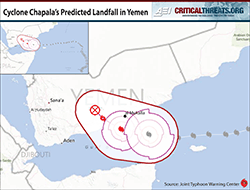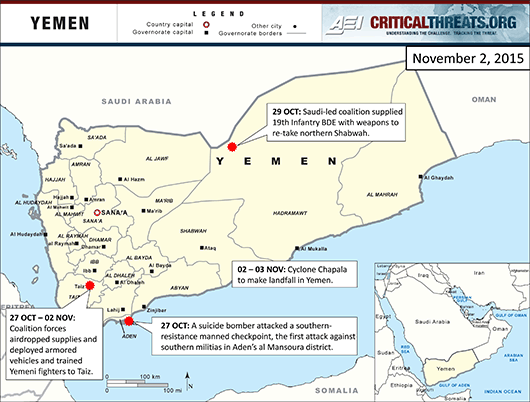The fighting in Yemen will probably escalate in advance of peace talks as both sides attempt to consolidate gains. These conditions, further exacerbated by a tropical storm to make landfall shortly, will create additional humanitarian challenges. Such challenges may weaken al Qaeda in the Arabian Peninsula's control over territory if AQAP is unable to respond effectively.
 |
A rare, powerful cyclone will strike Yemen’s eastern coastline within the next 48 hours and may challenge AQAP’s position as the group must handle the aftermath of the storm. Cyclone Chapala, which has dropped from a Category 4 to a Category 3 storm, will likely hit Mahrah and Hadramawt governorates in Yemen with winds of over 100 mph and heavy rain, with the center of the storm passing over al Mukalla in Hadramawt. The AQAP-controlled port city of al Mukalla will experience more than seven times its average rainfall and strong storm surges, placing the area at risk for flooding and landslides. AQAP already appears to have evacuated coastal neighborhoods in al Mukalla, but it is not clear whether AQAP will be able to respond effectively after the storm passes through. Chapala killed at least two people when it struck the Yemeni island of Socotra earlier.
AQAP and Islamic State in Iraq and al Sham-linked activity continues in recently “liberated” territory, especially in Aden. Islamist militants threw a bomb into Aden University campus, causing property damage, on October 28. ISIS Wilayat Aden-Abyan militants distributed fliers on October 26 warning the university to enforce prayer and to ban the mixing of the sexes and music. A suicide bomber attacked a southern resistance-manned checkpoint in Aden’s Mansoura district, killing two fighters on October 27. Suspected AQAP gunmen were behind a prison break in Aden on October 25 that reportedly released an AQAP militant. An AQAP representative also denied the reports that the group had been negotiating with Abdu Rabbu Mansour Hadi’s government. AQAP is also actively fighting against the al Houthis in al Bayda, where it recently claimed a series of attacks. (Statement obtained and translated by SITE.)
The UN special envoy to Yemen is pushing for peace talks to be held by the middle of November. UN Special Envoy to Yemen Ismail Ould Cheikh Ahmed is working to bring representatives from all sides to the table. A UN team met with al Houthis and representatives of former Yemeni President Ali Abdullah Saleh in Muscat, Oman, and are now in Riyadh, Saudi Arabia, meeting with representatives of Hadi’s government. The current round of negotiations is to set the terms for the peace talks. Saudi Foreign Minister Adel al Jubeir appeared more open to talks in an October 31 statement. He described the Yemeni conflict as being in its “final stage,” and noted the al Houthis “have every right to be part of the Yemen political process.” The head of the al Houthis’ political council Saleh al Samad seemed to indicate a shift in the al Houthis’ position away from openness to talks toward wariness over their outcome. Samad accused Ismail Ould Cheikh Ahmed of working in the coalition’s interests. Al Houthi-aligned forces continue attacking along the Saudi Arabian border, killing two foreign residents in Najran province on October 27.
The Saudi-led coalition is increasing its support for Yemeni fighters aligned against the al Houthi and Saleh forces. The coalition deployed about 30 UAE-supplied armored vehicles to Taiz, one of the main battlefronts in Yemen, to support allied militias in the central city. It is not clear whether Emiratis or Yemenis are manning the vehicles. A 500-man Yemeni force deployed from Aden to Taiz, though an ambush late on November 1 killed about a dozen of the fighters. Freshly trained Yemeni pilots ran sorties from the repaired al Anad airbase in southern Lahij governorate, striking targets in Taiz and al Bayda governorates. The coalition also airdropped at least two weapons shipments and supplies to forces in al Dhubab, Taiz, on October 27 and 28. On the Ma’rib front, the coalition delivered “sophisticated” weapons to the 19th infantry brigade now based in northern Hadramawt to support an operation to secure northern Shabwah, where the brigade’s headquarters are.
Humanitarian assistance becomes a political tool as conditions remain critical in Yemen. Aid shipments have repeatedly been diverted in order to support both sides of the war in Yemen. Recently, al Houthis confiscated a UN shipment destined for Raymah governorate, southwest of Sana’a, claiming the convoy was moving weapons. The al Houthis have also laid siege to Taiz for the past five weeks, preventing food and water shipments from entering the city. Security and road conditions present a challenge for humanitarian aid shipments. Coalition airstrikes destroyed multiple bridges along primary access routes around Sana’a, and fighting prevents deliveries from entering key terrain in Taiz, Ma’rib, and al Bayda.
The frontlines in Yemen are likely to remain relatively fixed as the Saudi-led coalition advances on natural lines within the human terrain. Both AQAP and ISIS will seize on opportunities to expand and strengthen as the conflict protracts.
Emily Estelle and Joshua Koontz contributed research.

